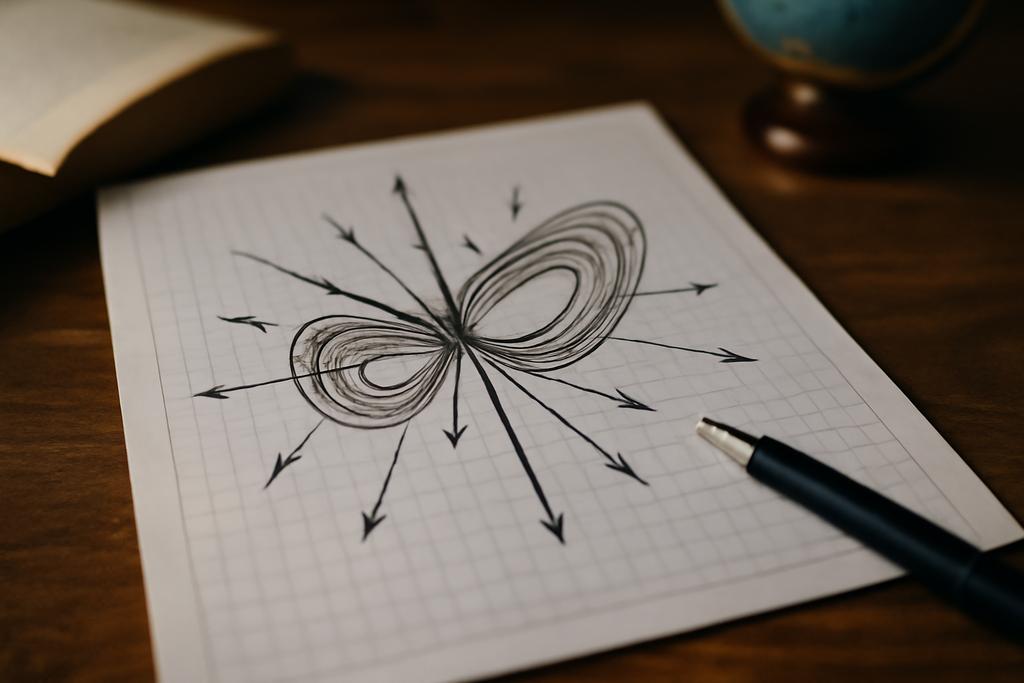The rhythm of the natural world isn’t a single drumbeat but a chorus of patterns that slip and slide between order and surprise. Turbulent air, convective storms, rainfall bursts, even the flicker of financial markets—these are all places where systems swing between calm and chaos in ways that look random until you pause to notice the structure underneath. A team of researchers from the University of Bologna and the Royal Meteorological Institute of Belgium has been probing that structure not with bigger data sets or fancier statistics, but with a closer, more intimate look at the directions in which tiny changes tend to grow or fade. Their work asks a simple, almost contrarian question: can we see the moment a system tips from one regime into another by watching the tiny, local geometry of its future trajectories? The answer, they suggest, is yes, and the clues show up in the language of Lyapunov vectors—directions in which perturbations grow or shrink—and in how those directions realign as a regime switch approaches.
In short, the paper embarks on a mission to turn intermittency from a global curiosity into a real-time forecasting problem. Intermittency is the pattern where a system toggles between qualitatively different behaviors—think calm periods punctuated by bursts of turbulence, or steady climate patterns interrupted by sudden shifts. Historically, scientists have studied these as averages or long-run tendencies. This new work, led by Alessando Barone and colleagues, charts a different map: a local, spatiotemporal perspective that hunts for precursors of regime change unfold in the immediate moment, across five representative dynamical systems. The promise is clear and consequential: if we can recognize these precursors, we might predict, and perhaps mitigate, dramatic transitions in weather, climate, or other complex systems before they unfold.
From global tallies to local telltales
Intermittency, in the vocabulary of chaos theory, is not a single mechanism but a family of routes to irregular behavior. Classical classifications—Type I, II, III, and beyond—come from studying how a system’s structure changes as a control parameter nudges the system toward or away from a bifurcation. The traditional approach has been to measure global statistics: how long laminar phases last, how often bursts occur, and how those patterns scale with the distance to a critical threshold. The new study flips that script. Instead of looking only at the big picture, it asks whether there are local indicators that appear right when a regime change is about to happen, and if those indicators can be tracked in real time as the system evolves.
To do this, the authors lean on a set of mathematical tools that are as geometric as they are statistical: covariant Lyapunov vectors (CLVs) and their companion Lyapunov exponents. A Lyapunov exponent measures how quickly a small perturbation to the system will grow or shrink on average. The CLVs, meanwhile, give you the specific directions in the system’s high-dimensional space where those perturbations unfold. If you imagine the system’s state as a point marching through a multi-dimensional landscape, CLVs tell you which “directions” are most dangerous to perturb in—where a tiny nudge could explode into a big change, or be crushed into oblivion by the system’s natural damping. The study uses these vectors as the building blocks for a local, real-time narrative of intermittency across five prototypical dynamical systems, including the famous Lorenz models and the Kuramoto–Sivashinsky equation, a classic spatio-temporal chaos exemplar.
In their global analysis, Barone and colleagues map how the spectrum of Lyapunov exponents (the LEs) and the geometry of CLVs evolve as parameters drift. But the real innovation lies in the local story: do the CLVs align or misalign in telling ways as a regime edge approaches? Do certain pairs or groups of CLVs line up in time with laminar periods, then scatter during bursts? By pairing CLV geometry with simple, robust indicators like the average laminar length and the fractal dimension of attractors, the team exposes a surprisingly universal thread: across very different systems and intermittency mechanisms, particular CLV alignments correlate with regime changes. The upshot is not a single magic predictor, but a portable toolkit—a way to read the dynamical handwriting of a system on the cusp of switching states.
Type-I intermittency in Lorenz 63 and the ghost of a limit cycle
One of the paper’s clearest demonstrations comes from the classic Lorenz 63 model, a tiny trio of coupled equations that became a lodestar for chaos theory. Type-I intermittency in this system is the pattern of laminar intervals tied to a lingering echo of a limit cycle, punctuated by chaotic bursts as the system wanders away and back again. The researchers show that as they dial the control parameter past the onset of intermittency, the leading Lyapunov exponent climbs from zero into positive territory, signaling the expansion of chaotic growth directions. Yet the most striking local signal is not the rate of growth per se, but how the covariant Lyapunov vectors reorient themselves in time.
When the system sits in the laminar regime, the CLVs behave in a coordinated, nearly orthogonal dance: they align in a way that reflects the lingering order of the subspace shaped by the prior limit cycle. As soon as a burst arrives, the vectors tilt, collide in new directions, and the pattern of alignment shifts. The authors quantify this with an average cosine of angles between CLVs, and they find a crisp, abrupt change right at the onset of intermittency. In other words, the geometry of perturbation growth—the way small causes translate into big effects—changes suddenly just as the system is about to exit the laminar corridor.
Beyond this qualitative shift, they connect micro-dynamics to a macro-statistical law. They show that the attractor’s fractal, or Kaplan–Yorke, dimension grows as the laminar length shortens, following a power law near the bifurcation. In practical terms, movies of the system display longer laminar episodes with fewer bursts near the threshold, but as soon as the threshold is breached, the attractor blossoms with more intricate structure. The tight link between a local CLV geometry and a global, coarse-grained diagnostic like dKY is precisely the kind of bridge that makes local indicators meaningful for real-world prediction.
A particularly striking takeaway is that CLVs can almost perfectly reconstruct the pre-intermittent limit cycle from local directional information. It’s as if peering at the precise directions of unstable growth reveals an almost telepathic ghost of the previous order, even as chaos lurks just beyond the laminar surface. That kind of reconstruction suggests a practical utility: if you can monitor these local alignments in a real system, you might anticipate when laminar periods will fail and bursts will begin.
Crises, merging attractors, and the Lorenz 96 echo chamber
The narrative broadens in Lorenz 96, a higher-dimensional chassis crafted to mimic atmospheric dynamics along a ring. Here the team explores a different flavor of intermittency—crises-induced intermittency that arises when attractors widen or merge as forcing parameters push the system through a parameter window. They uncover a remarkable pattern: certain intervals feature two coexisting attractors that each have their own periodic windows, and as the forcing crosses a critical line, the two attractors collide with the boundary that separates their basins of attraction. The result is a crisis that suddenly joins what were previously separate dynamical worlds, producing a new regime of intermittent behavior.
The local diagnostic work here is especially rich. The researchers measure CLV angles across the Lorenz 96 state space and find that different CLV pairs can signal the impending crisis, with some pairs catching the approach to a burst more reliably than others. In one configuration, two CLVs—one representing an unstable direction and another a stable direction—begin to align and misalign in a pattern that tracks the turbulence between the two attractor regions. The upshot is both subtle and powerful: a high-dimensional system with symmetry can harbor multiple “precursors” hidden in the geometry of perturbation growth, and those precursors can be harnessed to forecast regime shifts.
In a broader sense, the L96 results emphasize how the interplay of global bifurcation structure and local tangent-space geometry can reveal the timing of a regime change even when the system contains multiple competing dynamical substrates. The work also signals a practical caveat: the most informative CLVs might depend on the specific attractor structure, the symmetry properties, and the initial energy of the system. But the very fact that a reduced, carefully chosen set of directions can track a crises-driven transition across a complicated landscape is a hopeful reminder that complex systems often hide their secrets in surprisingly sparse coordinates.
Kuramoto–Sivashinsky and a global energy lens on intermittency
The Kuramoto–Sivashinsky equation is a staple in the study of spatio-temporal chaos: a partial differential equation whose solutions smear across space and time in a dance of waves and ripples. In this system, the authors observe a global, space-spanning intermittency: the entire spatial domain flips between laminar-like behavior and tumultuous bursts in unison, driven by a single viscosity parameter. Because the whole domain switches together, the authors pivot from local CLVs to a global observable—namely the energy of the field and its time derivative, which serves as a brisk proxy for variability.
Here again the CLV machinery yields surprising leverage. While the KSE’s spectrum reveals a degenerate zero set—at least at certain parameter values—the authors show this degeneracy owes to the equation’s translational symmetry. In a space with periodic boundaries, a family of periodic orbits can slide around the ring, producing a zoo of similar states all with the same energy scale. The initial condition, then, acts as a third parameter, shaping which member of this family the system evolves along. The analysis uncovers a practical recipe: by tracking the angle between the first two CLVs (the most unstable directions) and coupling that with the energy derivative , one can distinguish laminar windows from chaotic bursts even when the signal is spread across space.
One of the paper’s clever moves is to move between time-domain observations and a spatially integrated energy perspective. By plotting the system’s trajectory in a space defined by the energy E and its rate of change , and then coloring the path by the CLV angle, the researchers show a striking correspondence: laminar segments occupy a dense, low-variability pocket where CLVs align, while bursts leave the phase-space in a more orthogonal, less predictable arrangement. The practical payoff is potentially large for real-world systems that are effectively spatially extended and highly symmetric, such as wide-coverage atmospheric or oceanic processes, where a single site’s time series may not capture the full story.
Beyond the methodological payoff, the KSE analysis highlights an important theme: even in systems with infinite dimensions, the geometry of tangent space—the way perturbations grow, align, and split—can be compressed into a small, informative set of indicators. The authors show that a handful of CLVs and an energy-based metric can illuminate the laminar-to-burst transitions and offer a reduced, computationally tractable lens on a problem that, at first glance, demands huge data and heavy statistics.
So what does this mean for predicting real-world transitions?
This isn’t a promise of a magic predictor that will forecast the next hurricane or the next climate regime with perfect certainty. It is, instead, a carefully argued blueprint for what real-time precursors could look like in complex, noisy systems. The core idea is elegant in its restraint: rather than waiting for a global statistical signature of intermittency, look for local, dynamical signatures that the system is reorganizing its internal geometry in a way that makes a regime shift more likely. The covariant Lyapunov vectors, long prized by theorists for their careful accounting of stretching and folding in phase space, become practical instruments when paired with robust, physically meaningful observables like laminar length, attractor dimension, and the energy tendency.
The five systems studied—the Lorenz 63 and Lorenz 96 models, Platt–Spiegel style on-off intermittency, a double-well crisis framework, and the Kuramoto–Sivashinsky equation—are, in a sense, a kaleidoscope. They were chosen not because they resemble any one real-world system, but because they showcase a wide variety of intermittency: local maps near bifurcations, crises-induced transitions, spatially extended dynamics, and the paradox of degeneracy under symmetry. The results suggest a surprising degree of universality: the same kind of CLV alignment signals can crop up across different mechanisms, offering a common grammar for if-not-when a regime shift will happen.
Crucially, the authors don’t pretend that CLVs alone solve the forecasting problem. They acknowledge the practical limits, including the need for careful estimation of reinjection distributions in type-I intermittency and the sensitivity of CLV measurements to system specifics. Yet they are optimistic about a generalizable lesson: local dynamical indicators, rooted in the geometry of perturbation growth, can be powerful complements to global statistics, especially in high-stakes contexts like weather and climate where the cost of missed regime shifts is high.
Another notable thread is methodological restraint combined with computational savvy. By showing how a drastically reduced subset of CLVs—sometimes as few as a dozen directions out of hundreds—can carry the most predictive weight, the paper points toward practical, scalable approaches for data-rich geophysical systems. This matters because full, high-resolution models are expensive and slow; a compact, physics-grounded diagnostic toolkit could be deployed in real-time forecasting, data assimilation, or even early-warning systems with far lower computational overhead.
Why this matters beyond theory
In a world where climate dynamics are getting messier and more consequential, understanding how and when regime shifts occur is not just a mathematician’s curiosity. It’s a search for the visible fingerprints of instability before catastrophe arrives. The work of Barone, Carrassi, Savary, Demaeyer, and Vannitsem takes a bold step toward making those fingerprints legible in real time, across a spectrum of representative systems. It’s a reminder that even in chaos there is structure—and that the geometry of how perturbations propagate through that structure can be a guide to the future rather than merely a mirror of the past.
As the authors note, their approach sits at the intersection of dynamical systems theory, data assimilation, and practical forecasting. That trifecta is where the hardest problems in climate science live: how to translate deep mathematical insight into tools that can run on real-time data streams, handle noise, and deliver actionable information to decision-makers. If these local indicators—carefully tracked CLV alignments, laminar-length trends, and energy tendencies—prove robust across more complex, realistic models, they could augment existing prediction frameworks with a real-time sense of how close a system is to tipping points. In meteorology, in ocean dynamics, in the complicated choreography of the atmosphere–ocean–land system, a few direction vectors might become a new kind of weather instrument—one that reads the weather’s own moving geometry rather than merely its current value.
The study’s implications extend beyond the weather and climate realm. Intermittency appears in neuroscience, economics, and even medicine, wherever a system hops between regimes in ways that are hard to predict but not entirely random. The CLV-based lens could, in principle, help diagnose when a neuronal network is approaching a critical transition, or when a market system is teetering between regimes of stability and volatility. The unifying idea is simple and powerful: the way perturbations grow is not a background detail but a map of the system’s near-future possibilities. The geometry of that map—the directions in which tiny errors amplify—may be the best bridge between theory and prediction we have for these stubborn, real-world transitions.
In the authors’ own words, the work offers a pathway to “design prediction tools in more realistic scenarios,” with potential applications to turbulent geophysical fluids, rainfall patterns, or atmospheric deep convection. If the promise holds, a future meteorologist could monitor a small set of directional indicators in near real time, and glean a warning of an approaching regime shift not from a distant statistical signature but from the way the system’s internal perturbations reorient themselves as dynamics churn. In other words, the shadows cast by tiny perturbations might illuminate the near future of our planet’s most complex, consequential systems—and that would be a remarkable victory for science translating abstraction into practical foresight.
Note on affiliation and authors: The study is conducted by researchers from the University of Bologna and the Royal Meteorological Institute of Belgium, with Alessando Barone as the lead author, alongside Alberto Carrassi, Thomas Savary, Jonathan Demaeyer, and Stéphane Vannitsem.










